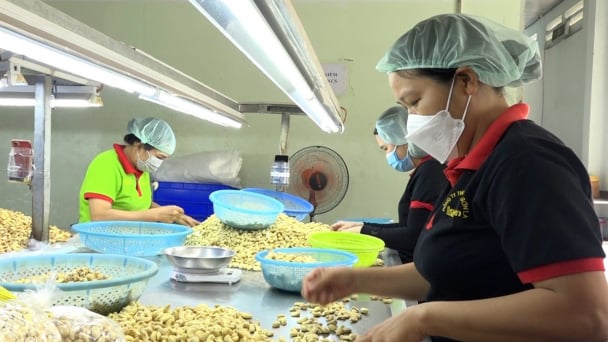May 24, 2025 | 16:21 GMT +7
May 24, 2025 | 16:21 GMT +7
Hotline: 0913.378.918
May 24, 2025 | 16:21 GMT +7
Hotline: 0913.378.918

Functional forces control pork before being sold at Binh Dien wholesale market. Photo: Nguyen Thuy.
From April 1, 2023, Ho Chi Minh City switched to industrial slaughtering and stopped manual slaughtering activities.
In Ho Chi Minh City, there are five concentrated, industrial-oriented cattle slaughtering factories in Cu Chi, Hoc Mon, and Binh Thanh districts.
The average total slaughter volume is 5,200 - 6,000 heads/day, accounting for about 60% of the total pork supply in the city market. 40% of the remaining pork volume is brought from the provinces to Ho Chi Minh City for consumption.
However, according to reflection, manually slaughtered pork from neighboring provinces is still brought to Ho Chi Minh City for consumption, affecting industrial slaughterhouses in Ho Chi Minh City.
Before this problem, Deputy Director of the Department of Agriculture and Rural Development of Ho Chi Minh City Nguyen Xuan Hoang said to ensure the interests of industrial slaughterhouses according to the policy of the People's Committee of Ho Chi Minh City, the Department has implemented many solutions.
Specifically, the Department coordinated with the Food Safety Management Board of Ho Chi Minh City to advise the People's Committee of Ho Chi Minh City to promulgate and implement synchronously and drastically the 4 Plans:
Plan for communication to bring cattle and poultry slaughtering into industrial-scale production;
Plan for management, market control, circulation, transportation, and trading of livestock and poultry meat;
Plan to increase cattle slaughter capacity at industrial slaughterhouses;
Plan to inspect the manual cattle slaughtering activities after the extension of the cattle and poultry slaughtering facilities expires.
Simultaneously, the HCMC Department of Agriculture and Rural Development will coordinate with District People's Committees to exchange, facilitate and connect traders at manual cattle slaughtering establishments to slaughter at industrial cattle slaughterhouses.
Also, mobilize, guide, and support industrial cattle slaughter plant investors to participate in city programs such as safe food chain, price stabilization, traceability, Ho Chi Minh City Agricultural Gold brand... to provide a safe food source for city consumers.
In addition, the Sub-Department of Livestock Production and Animal Health of Ho Chi Minh City cooperates with functional sectors such as the Food Safety Management Board, the Market Management Department, and district and inter-sectoral delegations to strengthen inspection and supervision. Monitor animal products from the provinces brought to the city for consumption at wholesale and traditional markets.

Ho Chi Minh City is the first locality to remove of manual slaughterhouses, switching to industrial slaughter. Photo: Nguyen Thuy.
The Ho Chi Minh City Department of Animal Husbandry and Animal Health coordinated with the city's interdisciplinary inspection teams to prevent and control livestock and poultry diseases (groups 1, 2, and 3) to strengthen inspection and supervision at the gateway to the city to detect and strictly handle the means of transporting animals and animal products from the provinces in contravention of regulations.
Coordinate with district and inter-sectoral delegations to strengthen inspection, blocking, monitoring, and strictly handling violations in illegal animal transportation, trading, and slaughtering in the area, especially areas bordering provinces and regions having manual cattle slaughtering establishments after the extension of the operation period expired under Decision No.231/QD-UBND.
Coordinate with departments, agencies, and district People's Committees to strengthen supervision and inspection of microbiological indicators, antibiotic residues, and banned substances of beta-agonist groups to ensure the safety of the source of animal products supplied to the market in the city, especially the source of slaughtered animal products from the provinces brought to Ho Chi Minh City for consumption, exchange, and information supply for the provinces to correct for cases with unsatisfactory monitoring results according to regulations.
According to Mr. Dinh Minh Hiep, Director of Ho Chi Minh City Department of Agriculture and Rural Development, when implementing the policy of stopping manual slaughter and switching to industrial slaughterhouses, the Department will strictly manage and limit the source of slaughtered meat from the provinces.
In addition, the Department has also submitted to the People's Committee of Ho Chi Minh City and the Ministry of Agriculture and Rural Development on the criteria that must be met to bring pork to Ho Chi Minh City for consumption. These criteria are equivalent to the slaughter requirements according to industrial slaughter standards. Thus, manual slaughter will not meet the criteria when bringing meat to the wholesale markets in Ho Chi Minh City for consumption, which means that traders move to manual slaughterhouses in the provinces, then transport Moving meat back to Ho Chi Minh City for consumption will face difficulties after the criteria are approved and implemented.
Translated by Ha Phuc
/2025/05/22/5250-1-184853_288.jpg)
(VAN) According to a representative from the Central Retail Vietnam, Vietnamese products such as seafood, sweet potatoes, dragon fruit, coffee, and spices hold great potential in the Thai market.

(VAN) A multi-channel, multi-directional strategy only works when the agricultural value chain meets global transparency and SPS standards.

(VAN) Market expansion is a matter of survival for Vietnamese businesses amid fierce competition and global supply chain fluctuations.

(VAN) Global market prospects for U.S. long-grain rice for the upcoming marketing year.

(VAN) China’s General Administration of Customs started permitting fresh durian shipments from Cambodia after a phytosanitary protocol was signed with the Cambodian Ministry of Agriculture in late April.

(VAN) To operate carbon market, one of the key issues is determining which types of 'commodities' meet the standards to be traded on the market.

(VAN) Durian-producing localities need to coordinate more effectively with central authorities to improve the traceability, monitoring, and response systems in case of violations.